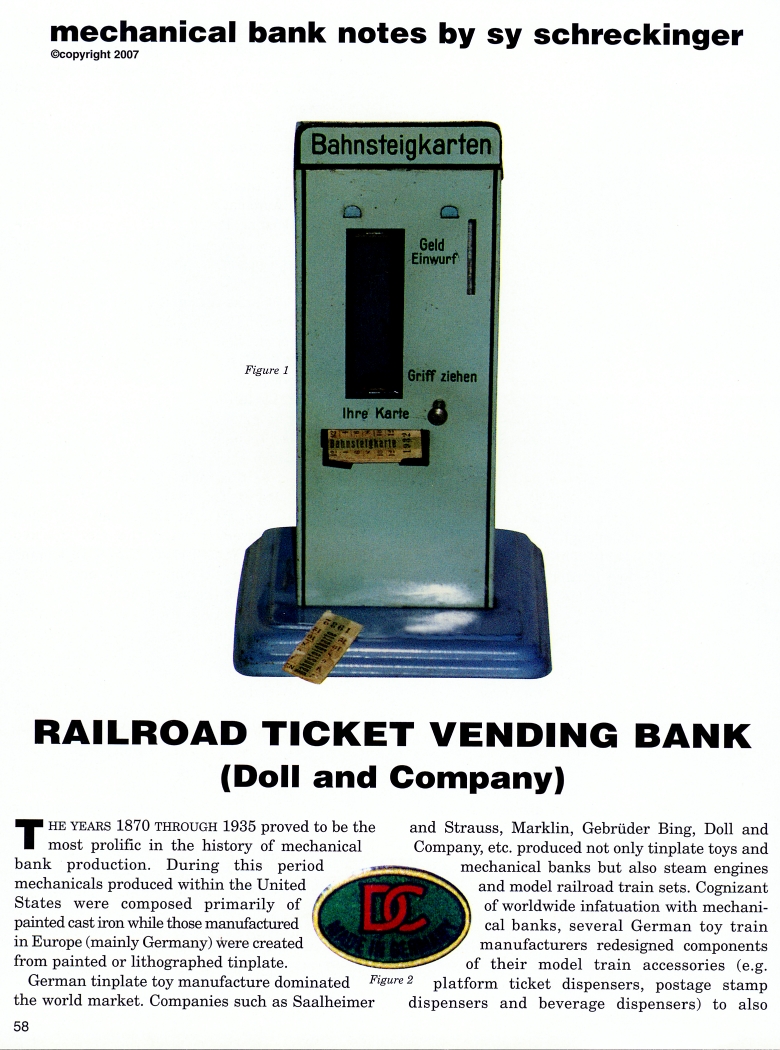|
Railroad Ticket Vending Bank
(Doll and Company)
by Sy Schreckinger – ANTIQUE TOY WORLD Magazine – November, 2007
The years 1870 through 1935 proved to be the
most prolific in the history of mechanical bank production. During this
period mechanicals produced within the United States were composed
primarily of painted cast iron while those manufactured in Europe (mainly
Germany) were created from painted or lithographed tinplate.
German tinplate toy manufacture dominated the world market. Companies
such as Saalheimer and Strauss, Marklin, Gebruder Bing, Doll and Company,
etc. produced not only tinplate toys and mechanical banks but also steam
engines and model railroad train sets. Cognizant of worldwide infatuation
with mechanical banks, several German toy train manufacturers redesigned
components of their model train accessories (e.g. platform ticket
dispensers, postage stamp dispensers and beverage dispensers) to also
function as mechanical banks. In most instances the conversion was
accomplished by simply adding a key lock retainer. Our featured subject, "Bahnsteigkarten"
(Platform Ticket Dispensing Bank) seen in Figure 1, is an example of one
such factory conversion.
"Bahnsteigkarten" was created by Doll and Company. Founded in 1898 by
Peter Doll and J. Sondheim, the company specialized in the production of
toy steam engines, steam accessories and model railroad sets. The factory
was located in Nurnberg, Germany, then the world center for manufacture of
fine tinplate toys and household items.
(As an aside, and of some interest, is this mechanical's name,
itself, i.e. "Bahnsteigkarten", translating to "Platform Tickets". Prior
to World War II, travelers purchasing "Platform Tickets" were the only
ones allowed into the boarding area of the train stations of Europe. This
is analogous to today's issuing of boarding passes to passengers at
airports.)
It is fortunate that the "Bahnsteigkarten" Mechanical Bank (Figure 1)
displays the Doll and Company logo. As seen in Figure 2, it is affixed to
the top of the bank. Such accessible identification aids both the
collector and historian to document the toy's heritage and approximate
date of manufacture.
Figure 3 is a Doll and Company catalog advertisement featuring two
other railroad vending banks, namely "Briefmarken-Automat" (Postage Stamp
Dispenser) and "Getranke-Automat" (Drink Dispenser). Although the "Bahnsteigkarten"
(Station Ticket Dispenser) is not pictured, construction and design
similarities support the contention that the trio comprises a set of three
vending banks manufactured by the company.
As examples of the conversions to mechanical banks, the following are
partial excerpts from the aforementioned Doll and Company sales catalog ad
(Figure 3), translated from German: "No. 861 Briefmarken-Automat":
...Postage Stamp Dispenser. D.R.G.M. (German Patent) ...Place a coin in
the slot, pull the knob and get one postage stamp...It is a postage stamp
machine and a coin savings bank...".
"No.867. Getranke-Automat": Drink Dispenser. D.R.G.M. (German Patent)
...Place a coin in the slot, press the lever and liquid comes out of the
spout, into the glass. The bank has a lock and key — so it is not only a
drink dispenser but a coin savings bank...".
"Bahnsteigkarten" is appreciated by, and appeals to, the model train
enthusiast as well as the mechanical bank collector. Its operation
commences with the insertion of a coin into the slot adjacent to the words
"Geld Einwurf' (i.e. Money Goes Here). This is followed by the words "Griff
Ziehen" (i.e. Pull the Knob"), after which a ticket is dispensed through
the slot marked "Ihre Karte" (i.e. Your Ticket). Ticket restocking and
coin removal are accomplished by opening the key lock back door of the
bank (Figure 4).
"Bahnsteigkarten Bank" is extremely rare. Less than a handful are
known to exist, and these in the collections of a few fortunate
individuals. Despite its simplistic design and diminutive size, i.e.
Height 5-3/4 inches, Width 2 inches, Depth 1-1/2 inches, "Bahnsteigkarten
Bank" is a highly desirable and attractive addition to a mechanical bank
collection.
Acknowledgement: The near mint example of "Bahnsteigkarten Bank"
(Figure 1), including its original platform tickets, is in the collection
of Bob Weiss.
|


